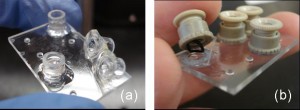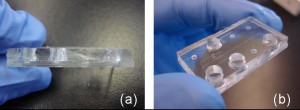Michael W. L. Watson and Aaron R. Wheeler
Department of Chemistry, University of Toronto, Ontario, Canada
Why is this useful?
Some applications for microfluidics, such as synthesis, reversed phase separations, and liquid-liquid extraction, require the use of organic solvents (e.g. acetonitrile, methanol, etc.). For such applications, glass or quartz substrates are preferred; however, even when using solvent-resistant substrates, such applications are often limited by the problem of connecting reservoirs to the substrate. As illustrated in Figure 1, common adhesives used for this purpose, such as epoxies and UV cured glues, are not able to withstand extended periods of exposure to solutions with high organic solvent content.
In this Tip, we report a straightforward solution to this problem: using an oxygen plasma bonded poly(dimethyl siloxane) (PDMS) reservoir manifold (Figure 2).
This structure is inexpensive, easy to apply, and is able to withstand a wide range of organic solvents for periods of up to several weeks.
What do I need?
- PDMS. We use the Sylgard 184 PDMS kit (Dow Corning Company), but any of a variety of PDMS formulations could be used.
- Vacuum chamber. An air-tight chamber that can be attached to a pump or house vacuum. We use a vacuum oven (Fisher Scientific Model 280A).
- Oven. PDMS can be cured at room temperature overnight, but the process is much faster in an oven.
- Plasma cleaner. We use a Harrick Plasma cleaner (Model PDC-001) to pre-treat glass and PDMS surfaces prior to bonding. An air plasma can be used but an oxygen plasma will yield a better seal.
- Glass microfluidic chip. Home-made or purchased glass or quartz microfluidic devices are required for work with strong organic solvents. We purchase chips from Caliper Life Sciences.
- Hole punch or coring tool. The reservoir volume is determined by the diameter of the holes in the manifold. We use either a coring tool with a diameter of 2 mm or a paper hole punch with a diameter of 5 mm.
What do I do?
- Mix PDMS and curing agent in a 10:1 weight ratio in a disposable weigh boat.
- Degas PDMS under vacuum.
- Pour the PDMS into a plastic Petri dish to a depth of about 3-4 mm.
- Cure PDMS for 1 hour at 70oC.
- Cut the PDMS with a scalpel to fit the shape of the microfluidic device.
- Punch holes through the PDMS such that they line up with the inlet ports in the microfluidic device. (For alignment, fit the PDMS manifold to the glass surface and use a Sharpie to mark the locations of the holes, prior to bonding, test-fit the manifold to ensure that the punched holes align with the microfluidic inlet ports.)
- Clean the glass device and manifold with deionized water and isopropanol and dry under a stream of nitrogen.
- Plasma treat the surfaces to be bonded under oxygen (5 psi O2, 400 mtorr vacuum, 26.9 W, 90 s).
- Bring the two surfaces together. Press down firmly for 20-30 s to ensure good seal formation.
- After use, the glass chip can be recycled by removing the PDMS slab with a razor blade and cleaning with acetone.
What else should I know?
These reservoirs provide a transparent alternative to opaque adhesives making it easier to visualize networks of channels and use optical detection methods. While some swelling is observed in solvents such as acetonitrile, the seal between the PDMS and glass does not leak, allowing for weeks of continued exposure to organic solvents. Note that highly aggressive solvents such as ethers or benzene are not compatible with this method.












